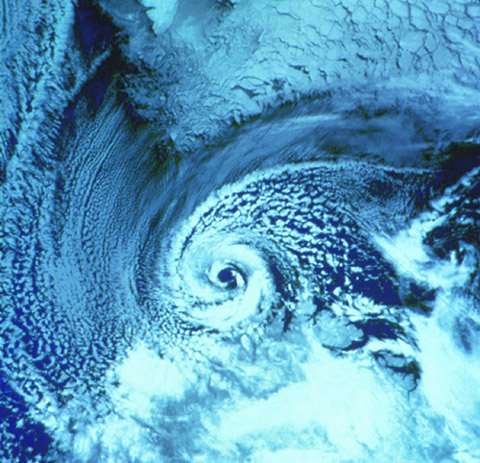Alan Condron, a Research Assistant Professor in the Climate System Research Center at the University of Massachusetts Amherst, uses MITgcm to investigate past and future climate sensitivity to changes in Arctic meltwater. Here MITgcm.org spotlights two recent papers: The first The impact of polar mesoscale storms on northeast Atlantic Ocean circulation co-authored with Ian A. Renfrew of UEA reports an exploration of the way in which atmospheric processes can regulate the formation of deep water in the subpolar North Atlantic Ocean and hence influence the large-scale ocean circulation with significant implication for climate modeling. The second Meltwater routing and the Younger Dryas co-authored with Peter Winsor UAF reports how a meltwater flood of waters from the Arctic likely triggered the Earth’s last major cold period – the Younger Dryas (12,9000 yrs BP).
Every year thousands of mesoscale storms, termed polar lows, cross the climatically sensitive northeast Atlantic ocean. These storms are often either too small or too short-lived to be captured in meteorological reanalyses or numerical models. Condron and Renfrew use a global, eddy-permitting ocean/sea-ice circulation configuration of MITgcm to run simulations with and without a parameterization of polar lows. The parameterization reproduces the high wind speeds and heat fluxes observed in polar lows as well as their integrated effects. The pair report an increase in the simulated depth, frequency and area of deep convection in the Nordic seas, larger northward transport of heat into the region, and southward transport of deep water through Denmark Strait: Strongly suggesting that polar lows are important for the large-scale ocean circulation and should be accounted for in short-term climate predictions.

The drainage pathways of meltwater stored in glacial lakes located along the southern margin of the Laurentide Ice Sheet. From Figure 1 of Condron and Winsor, 2012
The Younger Dryas—the last major cold episode on Earth—is generally considered to have been triggered by a meltwater flood into the North Atlantic. The prevailing hypothesis, proposed by Broecker et al. (1989), suggests that an abrupt rerouting of Lake Agassiz overflow through the Great Lakes and St. Lawrence Valley inhibited deep water formation in the subpolar North Atlantic and weakened the strength of the Atlantic Meridional Overturning Circulation (AMOC). More recently, Tarasov and Peltier (2005) showed that meltwater could have discharged into the Arctic Ocean via the Mackenzie Valley ∼4,000 km northwest of the St. Lawrence outlet. Condron and Winsor use a high-resolution, ocean sea-ice configuration of MITgcm to study the delivery of meltwater from the two drainage outlets to the deep water formation regions in the North Atlantic. Unlike Broecker et al.’s hypothesis, freshwater from the St. Lawrence Valley advects into the subtropical gyre ∼3,000 km south of the North Atlantic deep water formation regions and weakens the AMOC by <15%. In contrast, narrow coastal boundary currents efficiently deliver meltwater from the Mackenzie Valley to the deep water formation regions of the subpolar North Atlantic and weaken the AMOC by >30%. Based on their results the pair conclude that meltwater discharge from the Arctic, rather than the St. Lawrence Valley, was more likely to have triggered the Younger Dryas cooling.
To find out more about these and other projects contact Alan
References
- Broeker, W. S. et al (1989), Routing of meltwater from the Laurentide Ice Sheet during the Younger Dryas cold episode, Nature 341, 318 – 321, doi: 10.1038/341318a0
- Condron A., and I. A. Renfrew (2013), The impact of polar mesoscale storms on northeast Atlantic Ocean circulation, Nature Geoscience 6, 34–37 (2013) doi: 10.1038/ngeo1661
- Condron A., and P. Winsor (2012), Meltwater routing and the Younger Dryas, PNAS 2012 109 (49) 19928-19933; published ahead of print November 5, 2012, doi: 10.1073/pnas.1207381109
Related Links
Here’s a different spin on effects of Arctic Cyclones NBC News more links
Importance of freshwater injections into the Arctic Ocean in triggering the Younger Dryas cooling PNAS Commentary


